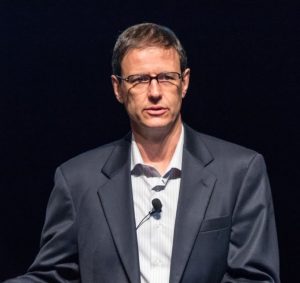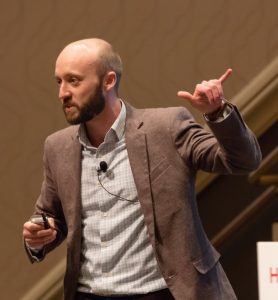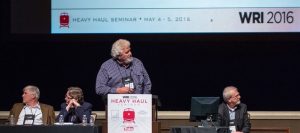Investigating Wear and Damage Mechanisms
WRI 2016, Heavy Haul Part 1
By Jeff Tuzik
The Railroad Industry isn’t known for rapid change. Slow and steady progress has generally characterized the industry approach to new technologies, maintenance strategies and operational practices. That’s beginning to change. Some of the changes the industry is grappling with are due to an increase in the rate of new technologies coming to market. Some of the changes are economic, driven by demands for heavier axle loads and longer trains. Some of the changes are due to an evolving understanding of the science of wheel/rail interaction.
Experts from various fields addressed some of these changes from several perspectives during the Heavy Haul portion the 2016 Wheel/Rail Interaction conference.
Many of the challenges and opportunities the North American railroad industry faces are shared by their international counterparts. Mike Roney, Principal of Iron Moustache Consulting, offered insight into the international perspective gleaned from information presented at the 2016 International Heavy Haul Conference (IHHC) in Perth, Australia.
North America is roughly in the middle of the global average in terms of axle load and train length, said Mike Roney, Principal of Iron Moustache Consulting. He added that one of the unique challenges facing the North American railroad industry is a combination of relatively old rights of way, mixed traffic, and non-captive fleets. As North American railways begin to increase axle loads and train lengths, that combination of factors will require some unique approaches and innovations. Australian iron ore railways, which don’t face the same restrictions as North America, currently run the heaviest axle loads in the world, at 44 tons; they’re also engaged in research and testing to move up to 50-ton loads. And while 44-ton axle loads aren’t in the foreseeable future for the U.S., Roney noted that 39-ton axle loads and 250-car consists are inevitable. “The increasing loads and lengths in places like Australia are a great case study in break-point railway engineering,” he said.
Other presentations at the IHHC discussed some of the technological innovations in inspection and automation around the world, Roney said. One example is China’s Daqin Railway, an ore and coal line that, at 375 MGT, is the heaviest annual tonnage line in the world. In order to accommodate their extreme volume, Daqin Railway recently implemented a system to streamline vehicle inspection by moving to camera-based inspection, and moving their inspectors indoors. Images are broken down by component and displayed to car inspectors’ computers where they are manually reviewed, Roney said. Daqin Railway claims that inbound train inspection times have been reduced from an hour down to 14 minutes, as a result. Many companies around the world are also looking into combining these kinds of image-based inspection regimes with machine intelligence, a move that many believe will both increase inspection accuracy and further reduce inspection times.
The Fortescue Metals Group ore line in Australia is another company pushing the boundaries of automation and remote operations. All their trains now run with a single driver; however all train control is run remotely from Perth, Roney said. “I think it’s safe to say that Australia will have the first fully automated heavy haul railroad in the world,” he added, noting that the three major ore lines in Australia are actively researching and testing full automation. One of the biggest factors driving the push for automation in Australia is the geographical remoteness of their mining operations.
The international nature of the IHHC also highlights industry practices that are common or becoming common on heavy-haul railroads regardless of where they operate, Roney said. Many of these practices have a direct impact on the mechanics of wheel/rail interaction; they include:
- Use of distributed power, typically in 4 locations
- ECP braking
- Single-driver operation with software assistance
- Real-time monitoring of train dynamics
- Use of both onboard and wayside detection systems, often combined with rules engines that prioritize work orders
- Optimized wheel and rail profiles
- Condition-based maintenance
- Expanded use of top of rail (TOR) friction modifiers and more intelligent use of gauge-face lubrication
- A 2mm tread hollow specification
These commonalities illustrate how beneficial it is for the industry as a whole to collaborate and share information as much as possible; “there’s no reason we have to keep rediscovering the same solution,” Roney said.
RCF Detection
One of the most pressing issues for all heavy-haul railways, whether international or domestic, is controlling rolling contact fatigue (RCF). “As we move to higher axle loads and use harder steels, controlling RCF is becoming more important,” Roney said. It’s a combination of factors that moves wheel and rail maintenance away from a heavy wear regime, into a heavy stress regime. As RCF becomes more prevalent, so do methods of preventing, removing and measuring it.
“In order to optimize the way RCF is managed, we have to be able to measure and quantify it,” said Eric Magel, Principal Researcher at the National Research Council Canada. With that goal in mind, Magel and the International Collaborative Research Initiative (ICRI) recently began work on a project with the goal of quantifying surface damage. Measuring the rate at which cracks develop and propagate is difficult in a laboratory using destructive testing methods – it’s significantly harder in the field using non-destructive testing. That’s where various electromagnetic (EM) measurement devices come in. Using either magnetic flux or eddy current, these devices are built to measure the top 5 to 7 mm of the rail head and report on the severity of RCF damage by way of crack length and depth. While some of these products like the MRX and Draisine see regular use in the European Union, North American railroads are still researching and validating the products – a crucial step for making a business use case.
The ICRI has been working with several railroads on EM testing trials since 2014, Magel said. The basic process for analysis is that railroads measure sections of track, then cut a rail sample and send it to the NRCC for laboratory analysis.
Results thus far have been mixed. One sample was measured by the MRX and Rohmann and Sperry devices to have crack depths of greater than their maximum measuring capacity (5 to 7mm, depending on the device). Back at the laboratory, longitudinal planing of the rail sample uncovered maximum crack depths of 3mm. It’s an example that’s indicative of other cases, Magel said. “In the work we’ve done so far, we’ve found that the EM devices consistently over-predict crack length and depth,” he said.
Cross validation of the measurement devices is also challenging. In comparing a number of samples with nominally light, medium and heavy RCF, it was found that the three devices tended not to agree on their crack depth measurements, and that no one device has proven more consistently accurate than another. “For the time being, we have to accept that the ability of EM systems to quantify the depth of cracking is limited,” Magel said.
The devices did, however, agree on the presence and general severity of the RCF damage, which can be valuable in its own right. That data can be used to trend RCF progression, for example, or to detect residual cracks during a grinding operation, Magel said.
The project is ongoing, with a number of railways and suppliers involved in testing and providing samples to the ICRI. Documentation of the samples and project data will also be summarized in an upcoming report to the Federal Railroad Administration, Magel said. In addition to EM testing, a number of suppliers and railroads are also beginning to explore the use of machine vision systems as part of their effort to catalogue and quantify rail surface damage.
Superelvation
In the recent past, an additional 1 to 2 inches of elevation in a curve was considered (and employed) as a solution to high rail wear and gauge widening, said Brad Kerchof, Director of Research and Tests at Norfolk Southern. The thought was that overbalance would cause vehicle dynamics to favor the low rail and thus reduce high rail lateral forces. This turned out to be a misguided effort; in theory and in practice, the reverse is true, he said.
Kerchof referenced two key points laid out by Harry Tournay, a senior scientist at the Transportation Technology Center Inc (TTCI), in a previously-published study, which make the case for under- rather than overbalance in curves to combat high wear and gauge spreading:
- Trains curving with excess curve elevation generally impose greater vertical loads on the low rail and greater steering traction on the lead axle, resulting in low rail RCF and high gauge spreading forces.
- Trains curving at underbalance elevation impose greater vertical loads on the high rail, however, curve with reduced angle of attack and generate lower lead axle steering traction with resulting lower L/V ratios.
A recent collaboration between Norfolk Southern (NS) and the TTCI sought to validate these statements, and to quantify the effects with a field study. The site of the field study needed to meet a number of criteria: relatively high degree of curvature, repeatable heavy axle-load consists, and an ascending grade that causes trains to operate at constant speed, Kerchof said. The selected site, in Mayberry, West Virginia, featured: a 4.5 degree curve, 3.5 inches of elevation, a 1.2% ascending grade, and a timetable speed of 40mph, a balance speed of 33mph, resulting in roughly two inches of underbalance.
The study focused on trains with 100 to 110 loaded gondola or hopper cars and two locomotives, and collected L/V data for each axle. Initial data showed that roughly 1% of the trains operating through the test site were near timetable speed, and the vast majority were operating at less than half of balance speed, Kerchof said.
One note of interest from the study showed that hopper cars, because of their high center of gravity, had a 10% higher weight transfer between the high and low rail than the lower center of gravity gondola cars. “Gravity, centrifugal force, coupler buff and draft forces all combine to influence steering and angle of attack,” Kerchof said.
The majority of the trains tested during phase 1 operated at 11.5mph through the 4.5 degree curve at the test site. Balance elevation for that degree of curvature and speed is only 4/10ths of an inch, said Kerchof. Meaning the majority of trains operated at 3.1 inch overbalance.
In phase 2 of the project, NS and TTCI remediated the overbalance; the test curve elevation was reduced from 3.5 inches to the NS minimum spec of 1 inch, resulting in a 17.5mph balance speed. With the majority of trains now operating much closer to balance speed, the data told a different story. The vertical load transfer difference between high and low center of gravity cars became virtually indistinguishable, Kerchof said. There were reduced gauge-spreading forces and a pronounced reduction in high rail L/Vs. The data also showed a slight, but somewhat counterintuitive, reduction in low rail L/Vs. “Lateral force on the low rail is generated by friction, and maximum lateral force occurs when friction is saturated,” Kerchof said, “so by reducing the normal force due to load transfer, maximum lateral force is also reduced.”
Ultimately the data that NS and TTCI collected dovetailed with Tournay’s theory. Mike Roney noted that the general consensus among IHHC participants is that running at 1 inch underbalance is an ideal target to aim for. Studies like those performed by NS and TTCI ultimately add value not just to the study participants, but to the domestic and international heavy haul industry by validating and quantifying these kinds of universally relevant practices.
Rail Integrity
Broken rail derailments are the most catastrophic events railroads have to contend with. The good news is, these events are rare. North American railroads see 12 broken rail derailments per million ton miles, Mike Roney said. “The Reduction in rail-caused derailments since beginning of the millennium is impressive.”
But in an era of rapid communication, and rapid political reaction to social pressure, every derailment is a clarion call. “If we’re not serious and proactive about [broken rail derailments], we run the risk of overregulation or regulation that is not in the best interest of the industry,” said Don Eadie, President of Don Eadie Consulting.
The most frequent cause of these derailments, accounting for roughly 50% of events, are transverse defects, which are largely related to older rail metallurgies, Eadie said. “As old rail is continually replaced, this figure will decrease.” The next most frequent cause is detail fractures. Detail fractures typically originate near the gauge corner, developing from head checks and RCF, and then grow rapidly across the rail head until a break occurs. Detail fractures also tend to be particularly catastrophic because they tend to kick off a chain reaction of nearby defects, resulting in multiple breaks, Eadie said.
The general failure mode of RCF-related rail defects occurs in three stages: initiation, growth and failure. Cracks typically begin to grow close to the surface, parallel to the direction of traffic, Eadie said. Eventually the crack growth direction turns downward into rail. In the early stages of crack growth, near the head of rail, residual compressive stress in the rail tends to slow the rate of crack propagation. “Once the crack moves beyond the arc of gauge corner collapse, then you’re in a zone of tensile residual stress,” he said. These tensile forces act to effectively wrench the defect apart.
Cracks initiated through RCF can also grow through hydro-pressurization, or the compression of liquids into the crack by passing wheels. Liquid inside of a crack reduces the coefficient of friction between the crack faces, and hydraulic pressure causes the tip of the crack to grow at an accelerated rate, Eadie said. “This is an area that needs a lot more research, particularly because it’s a critical point in the crack growth timeline.”
During the next phase of growth, cracks develop outside the influence of contact forces. The defect is primarily influenced by rail longitudinal stress, a combination of residual stress, bending stress, and thermal stress. During this phase, monitoring defect development is difficult, and the rate of growth can vary greatly, Eadie said. As a result, it’s important to control longitudinal stress as much as possible. A major component of this is controlling thermal stress by laying rail at the optimal neutral temperature. “[Laying rail at] a high neutral temperature to prevent sun kinks is common practice, but the downside is that low temperatures give you a higher change in temperature versus neutral as a result,” he said. For this reason, it’s important that rail neutral temperature take into account local environmental factors and seasonal temperature variations. Eadie added that rail de-stressing should be considered in some cases – the cost of which is easily offset by preventing a broken rail derailment.
Once defects grow to a critical level, the rail is susceptible to a catastrophic failure – a combination of defect size, dynamic impact load and longitudinal stress will eventually lead to a fracture or multiple fractures. The “impact” part of the equation can come from a number of sources – car body dynamics, track modulus or wheel load impacts.
High wheel impact loads are often the result of wheel flats or out-of-round wheels, and are traditionally detected through the use of wayside wheel impact load detectors (WILDs). WILDs are an accurate and proven method for impact load monitoring, but because there are roughly 150 WILD sites in North America, the coverage and sampling rate leaves room for improvement, said Brad Hopkins, Project Engineer, Condition Monitoring at Amsted Rail. In a recent study and proof-of-concept, Amsted Rail took a new approach to wheel impact monitoring by collecting data from truck mounted accelerometers (also known as truck performance detectors or TPDs) and processing it through machine learning.
The project collected data from a large number of accelerometers mounted to truck bearing adapters. The data was then used to train a neural network to recognize the distinguishing features of flats, as they appear in the accelerometer data. “Consider a 36-inch wheel traveling at 46 mph,” Hopkins said, “a wheel flat will hit 6.5 times every second — a 6.5 hertz frequency.” By cleaning up the signal data and applying a number of filters, wheel impacts can be differentiated from ambient vibration or track perturbations, he said.
The Amsted project shows that useful wheel impact data can be gathered on a continuous basis to pinpoint problematic wheels, hopefully before encountering a critically compromised section of rail.
But the ideal approach is to address RCF before cracks reach the critical stage. Preventive grinding within the “magic wear rate” interval – that is, cyclically removing surface cracks before they grow too deep into the rail head – is one of the most effective ways to address RCF during the crack initiation phase, Eadie said. Top of rail (TOR) friction management is another tool that is designed to mitigate RCF formation and the early stages of crack growth. “Friction management is widely used in shallow curves today, but there’s a big opportunity to expand into more areas, because the science backs up the rail savings,” Eadie said.
The mechanics of broken rail derailments are particularly relevant considering the Federal Railroad Administration (FRA)/Rail Safety Advisory Committee (RSAC) current look into the potential to establish limits for rail head wear, as a way of reducing the occurrence of broken rail derailments. “There are clearly a number of ways to reduce the number of broken rail derailments, the question is: Are wear limits one of them?” said Bob Tuzik, Editor-in-Chief of Interface Journal, and moderator of a panel discussion on rail integrity at the conference.
Mike Roney pointed out that the Class 1 railroad with the most liberal rail wear limits, also has the fewest rail-caused derailments, historically. This helps illustrate the concept that fatigue-related defects are more causally linked to broken rail derailments than wear. In the calculus of preventive grinding and the magic wear rate, the action of wear is counter to RCF. “A highly worn rail may also be highly fatigued, but they don’t go hand-in-hand,” Roney said. In fact, a rail experiencing high wear is less likely to develop deep RCF defects, Don Eadie added. Transverse defects and detail fractures, which make up the vast majority of broken rail derailments may feature significantly worn rail as a contributing factor, but there is no evidence that it is a driving factor, he said.
In addition to the potential causes of broken rails, the ways in which railroads have lowered their broken rail derailment rates also sheds light on the issue. CSX, for example, attributes their year over year reduction in broken rail derailments to a combination of factors, including expanded use of TOR friction modifiers, increased frequency and accuracy of ultrasonic rail flaw detection, advanced rail grinding programs, and a holistic rail health model that takes into account factors like rail age, defect history, curvature and grade, wear and predicted wear. “We also look at clusters of defects and non-urgent alerts as indicative of something potentially serious going on,” said Brad Spencer, Director of Train Accident Prevention at CSX. This type of complex, holistic approach that has successfully reduced the occurrence of broken rail derailments on CSX, and in fact throughout the industry, highlights the insufficiency of a single metric like rail wear to evaluate the likelihood of a rail break.
Greg Fowler, Senior Investigor at the Transportation Safety Board of Canada, noted that while worn rail is unlikely to be a major factor in a rail break, it can contribute to the event in other ways. Heavy wear and poor surface conditions, for example, can obfuscate ultrasonic flaw detection causing potentially severe defects to go unnoticed. Worn rail is also less resistant to any dynamically applied bending or torsional stress, he said. Fowler added, however, that “a uniformly-applied rail wear limit isn’t a precise way of targeting rail breaks.”
Tightening rail wear limits in service of reducing broken rail derailments could also have the unintended consequence, Roney said, of a chilling effect on rail grinding. If a particular section of rail is too near its condemning limit and a railroad deems it economically infeasible to grind, RCF-related defects could propagate through the rail faster and worsen the situation; “perhaps unlikely, but we have to consider these kinds of hypotheticals.” he said.
The discussion on rail wear limits in relation to broken rail derailments is ongoing. RSAC recommendations will likely continue to take shape as experts weigh in on the matter, and as new studies are published. The industry may have to accept some change to their current rail maintenance and monitoring and overall asset management regimes. But the rapid progress – the adoption of new technologies, new maintenance and operational models on display at WRI 2016 indicates that the industry today more is more nimble than ever.

All photos courtesy of Jack Lindquist
Jeff Tuzik is Managing Editor of Interface Journal





